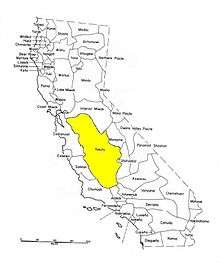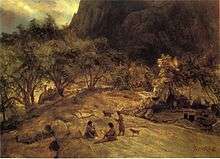Yokuts
The Yokuts (previously known as Mariposas[4]) are an ethnic group of Native Americans native to central California. Before European contact, the Yokuts consisted of up to 60 tribes speaking several related languages.

 Chukchansi Yokuts woman, photo by Edward Curtis, 1924 | |
| Total population | |
|---|---|
| 6,273 alone and in combination[1] (2010) | |
| Regions with significant populations | |
| Languages | |
| English, Yokuts language[2] | |
| Religion | |
| traditional tribal religion, Christianity, Kuksu religion,[3] previously Ghost Dance[3] | |
| Related ethnic groups | |
| Maidu, Miwok, Ohlone, and Wintu peoples |
Some of their descendants prefer to refer to themselves by their respective tribal names; they reject the term Yokuts, saying that it is an exonym invented by English-speaking settlers and historians. Conventional sub-groupings include the Foothill Yokuts, Northern Valley Yokuts, and Southern Valley Yokuts.[5]
Territory
Yokuts tribes populated the San Joaquin Valley,[2] from the Sacramento-San Joaquin River Delta ("the delta") south to Bakersfield and the adjacent foothills of the Sierra Nevada mountain range, which lies to the east.
In the northern half of the Yokuts region, some tribes inhabited the foothills of the Coast Range to the west. There is evidence of Yokuts inhabiting the Carrizo Plain and creating rock art in the Painted Rock area.
Population
.jpg)
Estimates for the pre-contact populations of most native groups in California have varied substantially (See Population of Native California). Alfred L. Kroeber in 1925[6] put the 1770 population of the Yokuts at 18,000.
Several subsequent investigators suggested that the total should be substantially higher.[7] Robert F. Heizer and Albert B. Elsasser 1980[8] suggested that the Yokuts had numbered about 70,000. They had one of the highest regional population densities in pre-contact North America.[2]
The 1850s were a devastating time for California Indians due to the incursion of European-American settlers into their homelands, who enslaved or killed the natives in great number. The federal government, which had recently acquired California after defeating Mexico in the Mexican War, signed a treaty (one of eighteen such treaties signed state-wide, setting aside seven and a half percent of California's land area) defining a proposed reservation and two hundred head of cattle per year.[9]
The US Senate failed to ratify any of the eighteen treaties in a secret vote cast on July 8, 1852, with every member either abstaining or voting no. The result of the vote was not made public until 1905. The newly organized state government took a different approach. In 1851, California Governor Peter Burnett said that unless the Indians were moved east of the Sierras, ‘a war of extermination would continue to be waged until the Indian race should become extinct.' [10]
Over the course of the next 50 years, settlers and eventually the California State Militia would wage war on the Yokuts and other native tribes in what became known as the Californian Genocide. The Yokuts were reduced by around 93% between 1850 and 1900, with many of the survivors being forced into indentured servitude sanctioned by the California State Act for the Government and Protection of Indians. A few Valley Yokuts remain, the most prominent tribe among them being the Tachi. Kroeber estimated the population of the Yokuts in 1910 as 600.
Today about 2000 Yokuts are enrolled in the federally recognized tribe. An estimated 600 Yokuts are said to belong to unrecognized tribes.[2]
Language
According to San Diego State University, the Yokutsan languages are members of the Penutian language family.[2]
Communities
Yokuts bands

Contemporary tribes
- Santa Rosa Rancheria (Tachi)
- Picayune Rancheria of Chukchansi Indians
- Table Mountain Rancheria (Mono)
- Tejon Indian Tribe of California
- Tule River Indian Tribe of the Tule River Reservation[12]
- Tuolumne Rancheria[2]
The contemporary Wukchumni and Choinumni communities do not yet have federal recognition.[12]
Trading routes
The Yokuts tribe of California are known to have engaged in trading with other California tribes of Native Americans in the United States including coastal peoples like, for example, the Chumash tribe of the Central California coast, and they are known to have traded plant and animal products.
Internal conflicts within the Chukchansi tribe near Yosemite
On 5 April 2015 (4-5-2015), it was reported that members of the Chukchansi tribe near Yosemite have been disenrolling other members from the tribe for decades, so that the tribe's casino profits go to fewer people. In the autumn of 2014, several disenrolled Chukchansi tribe members (who were no longer receiving a share of casino profits) arrived at the Chukchansi Gold Resort & Casino armed with guns, and violence ensued. As a result, a federal judge ordered that the casino be shut down.[13]
Notable Yokuts
- Estanislao
- Clay James
Tribal government
Every tribe has a Head Chief, Winatun, and a Village Chief.
-Researched by Mary Ann Brensel[14]
Gallery
.jpg) A Chukchansi woman and child, California, ca. 1920
A Chukchansi woman and child, California, ca. 1920.jpg) Dick Neal, a member of the Chukchansi tribe, California, ca. 1920
Dick Neal, a member of the Chukchansi tribe, California, ca. 1920.jpg) Young members of the Chukchansi tribe, California, ca. 1920
Young members of the Chukchansi tribe, California, ca. 1920.jpg) A Chukchansi woman preparing acorns for grinding, California, ca.1920
A Chukchansi woman preparing acorns for grinding, California, ca.1920
Notes
- "2010 Census" (PDF). www.census.gov. Retrieved 9 March 2015.
- California Indians and Their Reservations: Y. San Diego State University Library and Information Access. 2009 (retrieved 29 June 2010)
- Pritzker, 157
- Powell, 1891:90–91.
- Pritzker, 211
- Kroeber 1925:883.
- Baumhoff 1963; Cook 1955; Wallace 1978.
- Heizer and Elsasser 1980:16.
- Gelya, Frank. ""The Un-ratified treaties of 1851" (PDF). Tule River Tribe. Archived from the original (PDF) on 2014-10-12. Retrieved October 7, 2014" (PDF). Archived (PDF) from the original on 2014-10-12.
- Walsh, Margaret (2009-06-01). "Review: Frontiers: A Short History of the American West, by Robert V. Hine and John Mack Faragher. New Haven, Conn.: Yale University Press, 2007". The Historian. 71 (2): 363–364. doi:10.1111/j.1540-6563.2009.00240_18.x. ISSN 0018-2370.
- Sydney M. Lamb. 1957. Mono Grammar. University of California. Berkeley PhD dissertation.
- Pritzker, 159
- "Millions At Stake In California Tribe Membership Dispute". NPR.org. 5 April 2015. Retrieved 1 August 2015.
- "Tribal Government | Tulare County History". tularecountyhistory.org. Retrieved 2017-12-21.
References
- Kroeber, A. L. 1910. On the Evidences of Occupation of Certain Regions by the Miwok Tribes, University of California Press, Berkeley, Vol. 6 No. 3 p. 370
- Kroeber, A. L. 1925. Handbook of the Indians of California. Bureau of American Ethnology Bulletin No. 78. Washington, D.C.
- Pritzker, Barry M. 2000. A Native American Encyclopedia: History, Culture, and Peoples. Oxford University Press, Oxford. ISBN 978-0-19-513877-1.
- Heizer, R. F., and A. B. Elsasser 1980. The Natural World of the California Indians, University of California Press, Berkeley. ISBN 0-520-03895-9.
External links
| Wikimedia Commons has media related to Yokut. |
| Wikisource has the text of the 1911 Encyclopædia Britannica article Mariposan. |
Further reading
- Baumhoff, Martin A. 1963."Ecological Determinants of Aboriginal California Populations". University of California Publications in American Archaeology and Ethnology 49:155–236.
- Cook, Sherburne F. 1955. "The Aboriginal Population of the San Joaquin Valley, California". Anthropological Records 16:31–80. University of California, Berkeley.
- Cummins, Marjorie W. (1978). The Tache-Yokuts, Indians of the San Joaquin Valley. Pioneer Publishing Company. ISBN 0-914330-24-1.
- Heizer, Robert F., and Albert B. Elsasser. 1980. The Natural World of the California Indians. University of California Press, Berkeley.
- Powell, John Wesley 1891. Indian Linguistic Families Of America, North Of Mexico, Government Printing Office, Washington, pages 90–91.
- Wallace, William J. 1978. "Southern Valley Yokuts". In California, edited by Robert F. Heizer, pp. 448–469. Handbook of North American Indians, William C. Sturtevant, general editor, vol. 8. Smithsonian Institution, Washington, D.C.
- Webb, Frederick 1910. 'Tachi' and 'Tammukan', in Handbook of American Indians North of Mexico, Government Printing Office.